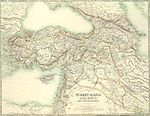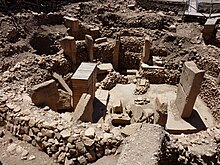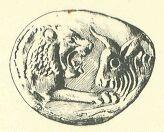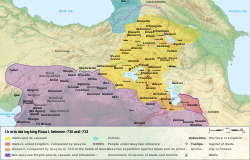Prehistory of Anatolia
This article needs additional citations for verification. (January 2024) |
| History of Turkey |
|---|
 |
| Timeline |
|
|
The prehistory of Anatolia stretches from the
The earliest representations of culture in Anatolia can be found in several archaeological sites located in the central and eastern part of the region. Stone Age artifacts such as animal bones and food fossils were found at Burdur (north of Antalya). Although the origins of some of the earliest peoples are shrouded in mystery, the remnants of Bronze Age civilizations, such as Troy, the Hattians, the Akkadian Empire, Assyria, and the Hittites, provide us with many examples of the daily lives of its citizens and their trade. After the fall of the Hittites, the new states of Phrygia and Lydia stood strong on the western coast together with Lykia and Caria. Only the threat from a distant Persian kingdom prevented them from advancing past their peak of success.
Stone Age
The Stone Age is a prehistoric period in which stone was widely used in the manufacture of implements. This period occurred after the appearance of the genus Homo about 2.6 million years ago[citation needed] and roughly lasted 2.5 million years to the period between 4500 and 2000 BC with the appearance of metalworking.
Paleolithic
In 2014, a stone tool was found in the Gediz River that was securely dated to 1.2 million years ago.
Evidence of fruit and of animal bones has been found at Yarimburgaz. The caves of the Mediterranean region contain murals.
Mesolithic
Remains of a mesolithic culture in Anatolia can be found along the Mediterranean coast and also in Thrace and the western Black Sea area. Mesolithic remains have been located in the same caves as the paleolithic artefacts and drawings. Additional findings come from the Sarklimagara cave in Gaziantep, the Baradiz cave (Burdur), as well as the cemeteries and open air settlements at Sogut Tarlasi, Biris (Bozova) and Urfa.[5]
Neolithic



Because of its strategic location at the intersection of Asia and Europe, Anatolia has been the center of several
.Çatalhöyük (Central Turkey) is considered the most advanced of these, and Çayönü in the east the oldest (c. 7250–6750 BC). We have a good idea of the town layout at Çayönü, based on a central square with buildings constructed of stone and mud. Archeological finds include farming tools that suggest both crops and animal husbandry as well as domestication of the dog. Religion is represented by figurines of Cybele, the mother goddess. Hacilar (Western Turkey) followed Çayönü, and has been dated to 7040 BC.[6]
Chalcolithic (Copper) Age
Straddling the Neolithic and early Bronze Age, the Chalcolithic era (c. 5500–3000 BC) is defined by the first metal implements made with copper. This age is represented in Anatolia by sites at Hacilar, Beycesultan, Canhasan, Mersin Yumuktepe, Elazig Tepecik, Malatya Degirmentepe, Norşuntepe, and Istanbul Fikirtepe.[7]
Bronze Age
The Bronze Age (c. 3300–1200 BC) is characterised by the use of copper and its tin alloy, bronze, for manufacturing implements. Asia Minor was one of the first areas to develop bronze making.
Early Bronze Age (3000–2500 BC)
Although the first habitation appears to have occurred as early as the 6th millennium BC during the Chalcolithic period, functioning settlements trading with each other occurred during the 3rd millennium BC. A settlement on a high ridge would become known as Büyükkaya, and later as the city of Hattush, the center of this civilization. Later still it would become the Hittite stronghold of Hattusha and is now Boğazköy. Remnants of the Hattian civilization have been found both under the lower city of Hattusha and in the higher areas of Büyükkaya and Büyükkale,[8] Another settlement was established at Yarikkaya, about 2 km to the northeast.

The discovery of mineral deposits in this part of Anatolia allowed Anatolians to develop metallurgy, producing items such as the implements found in the royal graves at Alaca Höyük, about 25 km from Boğazköy, which it preceded, dating from 2400 to 2200 BC. Other Hattian centers include Hassum, Kanesh, Purushanda, and Zalwar.[9][10][11][12][13] During this time the Hattians engaged in trade with city-states such as those of
Anatolia had remained in the prehistoric period until it entered the sphere of influence of the Akkadian Empire in the 24th century BC under Sargon of Akkad, particularly in eastern Anatolia. However, the Akkadian Empire suffered problematic climate changes in Mesopotamia, as well as a reduction in available manpower that affected trade. This led to its fall around 2150 BC at the hands of the Gutians.[14] The interest of the Akkadians in the region as far as it is known was for exporting various materials for manufacturing. Bronze metallurgy had spread to Anatolia from the Transcaucasian
Middle Bronze Age (2500–2000 BC)
At the origins of written history, the Anatolian plains inside the area ringed by the Kızılırmak River were occupied by the first defined civilization in Anatolia, a non-Indo-European indigenous people named the Hattians (c. 2500 BC – c. 2000 BC). During the middle Bronze Age, the Hattian civilization, including its capital of Hattush, continued to expand.[10] The Anatolian middle Bronze Age influenced the early Minoan culture of Crete (3400 to 2200 BC) as evidenced by
Late Bronze Age (2000–1200 BC)

Hattians
The Hattians came into contact with Assyrians traders from Assur in Mesopotamia such as at Kanesh (Nesha) near modern Kültepe who provided them with the tin needed to make bronze. These trading posts or Karums (Akkadian for Port), have lent their name to a period, the Karum Period. The Karums, or Assyrian trading colonies, persisted in Anatolia until Hammurabi conquered Assyria and it fell under Babylonian domination in 1756 BC. These Karums represented separate residential areas where the traders lived, protected by the Hattites, and paying taxes in return. Meanwhile, the fortifications of Hattush were strengthened with construction of royal residences on Büyükkale.
After the Assyrians overthrew their
Hittites

The history of the Hittite civilization is known mostly from
Old Kingdom
Hattian civilization was also impacted by an invading Indo-European people, the Hittites, in the early 18th century BC, Hattush being burned to the ground in 1700 BC by King
The Old Hittite Empire (17th–15th centuries BC) was at its height in the 16th century BC, encompassing central Anatolia, north-western Syria as far as Ugarit, and upper Mesopotamia. Kizzuwatna in southern Anatolia controlled the region separating the Hittite Empire from Syria, thereby greatly affecting trade routes. The peace was kept in accordance with both empires through treaties that established boundaries of control.
Middle Kingdom
Following the reign of Telipinu (c. 1460 BC) the Hittite kingdom entered a relatively weak and poorly documented phase, known as the Middle Kingdom, from the reign of Telipinu's son-in-law, Alluwamna (mid-15th century BC) to that of Muwatalli I (c. 1400 BC).
New Kingdom
King
It was not until the reign of King Suppiluliumas (c. 1344–1322 BC) that Kizzuwatna was taken over fully, although the Hittites still preserved their cultural accomplishments in Kummanni (now Şar, Turkey) and Lazawantiya, north of Cilicia.[18]
In the 13th century, after the reign of
Syro-Hittite era
After 1180s BC, amid general turmoil in the
Mycenaean presence
There is very little information about early Mycenaean presence in Anatolia. Miletus was clearly a center of Mycenaean presence in Asia Minor in the period c. 1450–1100 BC. The zone of intense Mycenaean settlement extends as far as Bodrum/Halicarnassus.[19]
The Mycenaean sphere of influence in Asia Minor is also relatively restricted geographically: Intense Mycenaean settlement is to be found in the archaeological records only for the region between the Peninsula of Halicarnassus in the south and Milet [Miletus] in the north (and in the islands off this coastline, between Rhodes in the south and Kos – possibly also Samos – in the north).[19]
Attarsiya was a 15th–14th century BC military leader who was probably Greek. He conducted the first recorded Mycenaean military activity on the Anatolian mainland. His activities are recorded in the Hittite archives of c. 1400 BC.[20]
British archaeologist
Iron Age
The

Western Anatolia
Troad
The Troad, on the Biga peninsula, was settled before 3000 BC. The site of Troy was occupied for more than three millennia, its archaeological layers numbered I-IX. Legends of the Trojan War may have a basis in historical events concerning Late Bronze Age Troy.[22][23][24]
Aeolis

Ionia
Ionia was part of a group of settlements on the central Aegean coast bounded by Lydia to the east, and
Lydia (Maeonia)


Lydia, or Maeonia as it was called before 687 BC, was a major part of the history of western Anatolia, beginning with the Atyad dynasty, who first appeared around 1300 BC. Lydia was situated to the west of Phrygia and east of the
.The
Under the reign of the last Lydian king Croesus, Lydia reached its greatest expansion. Persia was invaded first at the
Following Croesus' defeat, Lydia fell under the hegemony of Persia, Greece, Rome and Byzantium until finally being absorbed into the Turkish lands.
Caria

Caria forms a region in Western Anatolia, south of
Lycia
Lycia formed the southernmost settlement in Western Anatolia on what is now the
Central Anatolia
Phrygia

The west-central area of Anatolia became the domain of the Phrygian Kingdom following the fragmentation of the
Well known from ancient Greek and Roman writers is
After Midas's death, Phrygia lost its independence, becoming respectively a vassal state of its western neighbour, Lydia, Persia,
era.Eastern Anatolia
Cimmeria

Cimmeria was a region of north eastern Anatolia, appearing in the 8th century BC from the north and east, in the face of the eastern Scythian advance. They continued to move west, invading and subjugating Phrygia (696–695 BC), penetrating as far south as Cilicia, and west into Ionia after pillaging Lydia. Lydian campaigns between 637 and 626 BC effectively halted this advance. The Cimmerian influence progressively weakened and the last recorded mention is in 515 BC.
Urartu

Urartu (Nairi, or the Kingdom of Van) existed in north-east Anatolia, centered around Lake Van (Nairi Sea), to the south of the Cimmerians and North of Assyria. Its prominence ran from its appearance in the 9th century until it was overrun by the Medes in the 6th century.
Urartu is first mentioned as a loose confederation of smaller entities in the
Following this Urartu suffered a number of setbacks. King
Assyria
In the Iron Age Assyria extended to include south eastern Anatolia. Assyria, one of the great powers of the Mesopotamia region, had a long history from the 25th century BC (Bronze Age) until it final collapse in 612 BC at the end of the Iron Age. Assyria's Iron Age corresponds to the Middle Period (resurgence) and the Neo-Assyrian Empire in its last 300 years, and its territory centered on what is modern day Iraq.
Assyria influenced Anatolian politics and culture from when its traders first came into contact with Hattians in the late Bronze Age. By the 13th century BC Assyria was expanding to its north west at the expense of the Hittites, and to the north at the expense of Urartu. Assyrian expansion reached its height under
With the death of Tiglath-Pileser I Assyria entered a period of decline during what is referred to as the Ancient Dark Ages (1075–912 BC) in the region that corresponded to the
However Assyria found its resources stretched to maintain the integrity of its vast empire and civil war again erupted following the death of Ashurbanipal. Vassal states stopped paying tribute, regaining independence. The weakened Assyrian state was now faced by a new threat, a coalition of Iranian peoples to its east and north, including Medes,
With the collapse of Assyria, ended not only the Iron Age, but also the era referred to as
See also
- History of Europe
- History of the Middle East
- Timeline of Middle Eastern history
- Anatolianism
- Ancient kingdoms of Anatolia
- Ancient Regions of Anatolia
- Ancient Near East
Notes
- ^ a b "1.2-Million-Year-Old Stone Tool Unearthed in Turkey". Archived from the original on 2020-11-11. Retrieved 2014-12-25.
- ^ Suthan 2009–2014, Paleolithic age
- ^ Manisa Museum Archived 2012-01-13 at the Wayback Machine, Republic of Turkey Culture minister website
- from the original on 2020-01-04. Retrieved 2012-02-18.
- ^ Suthan 2009–2014, Mesolithic age
- ^ Suthan 2009–2014, Neolithic age
- ^ Suthan 2009–2014, Chalcolithic age
- ^ A Brief History of Hattusha/Boğazköy Archived 2012-05-27 at archive.today
- ^ "The History Files: Hatti (Hattusa)". Archived from the original on 2020-07-25. Retrieved 2012-02-18.
- ^ a b c "Expedition in Ancient Anatolia: Hattians - First Civilizations in Anatolia". Archived from the original on 2011-07-08. Retrieved 2012-02-18.
- ^ "The Joukowsky Institute of Archaeology: The Archaeology of Mesopotamia". Archived from the original on 2013-12-09. Retrieved 2012-02-18.
- ^ The Hittites, their forerunners and their followers Archived 2012-08-03 at archive.today
- ^ Burney CA. Historical dictionary of the Hittites: Kültepe. Scarecrow Press, 2004, Lanham MD
- ISBN 978-0-520-20222-1.
- ^ ISBN 978-0-19-872194-9.
- ^ Trevor Bryce, The Kingdom of the Hittites, rev. ed, 2005:9.
- ^ C. Michael Hogan, Knossos fieldnotes, Modern Antiquarian (2007) Archived 2017-11-08 at the Wayback Machine
- ISBN 978-3-11-014870-1.
- ^ a b Hajnal, Ivo; Posch, Claudia (2009). "Graeco-Anatolian Contacts in the Mycenaean Period". Sprachwissenschaft Innsbruck Institut für Sprachen und Literaturen. Archived from the original on 13 July 2021. Retrieved 4 April 2015.
- ^ Kelder, Jorrit (2004–2005). "The Chariots of Ahhiyawa". Dacia, Revue d'Archéologie et D' Histoire Ancienne (48–49): 151–160. Archived from the original on 2022-01-20. Retrieved 2017-12-03.
- ^ Cook, J. M. (1959–1960). "Greek Archaeology in Western Asia Minor". Archaeological Reports (6): 27–57
- .
- ISBN 978-0-415-34959-8.
- ISBN 978-0199873609.
- ^ Duncker, Max (1879). The History of Antiquity, Volume III. Richard Bentley & Son.
- ^ Encyclopædia Britannica Online. "Phrygia". Archived from the original on 2007-10-30. Retrieved 2007-10-19.
- ^ Encyclopædia Britannica Online. "The legends and the truth about King Midas". Archived from the original on 2011-07-27. Retrieved 2007-10-19.
References
- Cambridge Ancient History Online 14 vols. 1970-2000
Note: The original 11 volCambridge Ancient History 1928-36 is now available as free ebooks - Cambridge Companions to the Ancient World. 10 vols.
- Duncker, Max (1879). The History of Antiquity, Volume III. Richard Bentley & Son.
- Hornblower, Simon; Antony Spawforth (1996). The Oxford Classical Dictionary. Oxford University Press.
- McEvedy, Colin (1967). The Penguin Atlas of Ancient History. Penguin.
- Marek, Christian (2010), Geschichte Kleinasiens in der Antike. C. H. Beck, Munich, ).
- Suthan, Resat (2009–2014). "Historical". Anatolia. Thracian Ltd.
Further reading
- Lazaridis, Iosif; et al. (August 2022). "The genetic history of the Southern Arc: A bridge between West Asia and Europe". S2CID 251843620.

